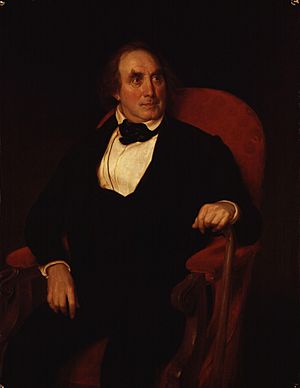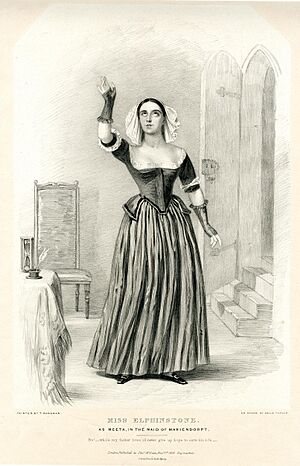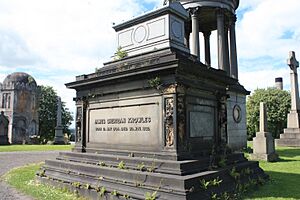James Sheridan Knowles facts for kids
Quick facts for kids
James Sheridan Knowles
|
|
|---|---|

James Sheridan Knowles by Wilhelm Trautschold
|
|
| Born | 12 May 1784 Cork, County Cork, Kingdom of Ireland |
| Died | 30 November 1862 Torquay, Devon, United Kingdom |
| Occupation | Dramatist and actor |
| Spouse | Maria Charteris |
James Sheridan Knowles (born May 12, 1784 – died November 30, 1862) was a talented Irish dramatist (someone who writes plays) and actor. He was related to the famous writer Richard Brinsley Sheridan. James Knowles became very successful writing plays that were performed in the popular West End theatres in London. Later in his life, he also wrote several novels.
Contents
Early Life and Talents
James Sheridan Knowles was born in Cork, Ireland. His father, James Knowles, was a lexicographer, which means he wrote dictionaries. The family moved to London in 1793. When James was just fourteen, he wrote a song called The Welsh Harper. This song became very popular after it was set to music.
His writing skills helped him become friends with important writers like William Hazlitt, Charles Lamb, and Samuel Taylor Coleridge. For a while, he served in the army, in groups called the Wiltshire and Tower Hamlets militia. After leaving the army, he studied medicine and became a doctor. He even worked as a vaccinator for a society that promoted vaccinations.
A Career in Theatre
Even though he could have continued as a doctor, Knowles decided to follow his passion for the stage. He started acting, probably in Bath, and even played the main role in Hamlet in Dublin. In 1809, he married Maria Charteris, an actress.
In 1810, he wrote a successful play called Leo, which featured the famous actor Edmund Kean. The next year, his play Brian Boroihme attracted large crowds in Belfast. However, he didn't earn much money from his plays at first. This led him to work as an assistant to his father at a school in Belfast.
In 1817, he moved to Glasgow, Scotland. There, he ran a successful school while continuing to write plays.
Famous Plays
Knowles had his first big success with Caius Gracchus, performed in Belfast in 1815. His play Virginius was written for the well-known actor William Charles Macready and was first performed in London in 1820.
In 1825, Knowles wrote William Tell, which became one of Macready's favorite roles. Knowles's most famous play, The Hunchback, was performed in 1832. Knowles himself received praise for his acting in this play, where he played the character Master Walter.
Other popular plays he wrote include:
- The Wife (1833)
- The Daughter (also known as The Wrecker's Daughter) (1836)
- The Love Chase (1837)
His 1839 play Love was highly praised by the famous writer Mary Shelley. His second wife, Emma Knowles, was also an actress.
Later Life and New Paths
In his later years, James Sheridan Knowles left the theatre world. He became a Baptist preacher and gave sermons that attracted many people. He also wrote two books where he discussed his views on certain religious topics.
In 1849, he started receiving an annual pension of £200 from Sir Robert Peel, a former Prime Minister. In his old age, he became a friend and mentor to a young writer named Edmund Gosse. Knowles is even mentioned in Gosse's famous book Father and Son.
James Sheridan Knowles passed away in Torquay on November 30, 1862. He is buried under a large tomb at the top of the Glasgow Necropolis.
Works

James Sheridan Knowles was a very productive writer, creating many plays, novels, and other works.
Plays
- Leo; or, The Gipsy (1810)
- Brian Boroihme; or, The Maid of Erin (1811)
- Caius Gracchus (1815)
- Virginius (1820)
- William Tell (1825)
- The Beggar's Daughter of Bethnal Green (1828)
- Alfred the Great; or The Patriot King (1831)
- The Hunchback (1832)
- A Masque (a short play about the death of Sir Walter Scott) (1832)
- The Wife; A Tale of Mantua (1833)
- The Beggar of Bethnal Green (1834)
- The Bridal (1837) (a version of an older play called The Maid's Tragedy)
- The Daughter (1837)
- The Love Chase (1837)
- Woman's Wit (1838)
- The Maid of Mariendorpt (1838)
- Love (1839)
- John of Procida; or, The Bridals of Messina (1840)
- Old Maids (1841)
- The Rose of Arragon (1842)
- The Secretary (1843)
- Alexina; or, True unto Death (1866)
Novels and Short Stories
- The Magdalen and Other Tales (1832)
- Fortescue (1846)
- George Lovell (1847)
- Old Adventures (1859)
- Tales and Novelettes etc. (1874)
Poetry
- A Collection of Poems on Various Subjects (1810)
- Fugitive Pieces
- The Senate, or Social Villagers of Kentish Town, a Canto (1817)
Theological Writings
- The Rock of Rome; or, The Arch Heresy (1849)
- The Idol Demolished by Its Own Priest (1852)
- The Gospel Attributed to Matthew in the Record of the Whole Original Apostlehood (1855)
Non-fiction
- The Elocutionist (1831) (a book about how to read aloud well)
- A Treatise on the Climate of Madeira (1850)
- The Debater's Handbook (1862)
- Lectures on Dramatic Literature (1875)




